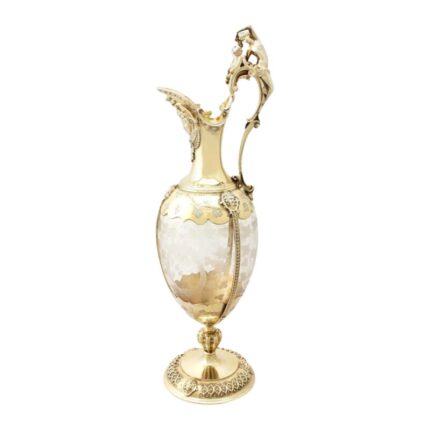The top with ormolu banded edge, the parquetry decoration exhibits a stunning array of exotic woods.
The attractive ormolu mounts only enhance the overall appearance of this superb piece of French craftsmanship. The table is raised on cabriole legs with ormolu mounts and feet.
The top opens to reveal a baize lined interior for playing cards, you then swivel the top to reveal the backgammon table.
Condition:
In excellent condition having been beautifully cleaned, polished and waxed in our workshops, please see photos for confirmation.
Dimensions in cm:
Height 78 cm x Width 82 cm x Depth 59 cm
Dimensions in inches:
Height 2 foot, 7 inches x Width 2 foot, 8 inches x Depth 1 foot, 11 inches
Parquetry –
is a geometric mosaic of wood pieces used for decorative effect. The two main uses of parquetry are as veneer patterns on furniture and block patterns for flooring. Parquetry patterns are entirely geometrical and angular—squares, triangles, lozenges.
The word derives from the Old French parchet , literally meaning “a small enclosed space”. Large diagonal squares known as parquet de Versailles were introduced in 1684 as parquet de menuiserie to replace the marble flooring that required constant washing, which tended to rot the joists beneath the floors.
Such parquets en lozange were noted by the Swedish architect Daniel Cronström at Versailles and at the Grand Trianon in 1693. Timber contrasting in color and grain, such as oak, walnut, cherry, lime, pine, maple etc. are sometimes employed; and in the more expensive kinds the tropical hardwoods are also used.
Ormolu – (from French ‘or moulu’, signifying ground or pounded gold) is an 18th-century English term for applying finely ground, high-carat gold in a mercury amalgam to an object of bronze.The mercury is driven off in a kiln leaving behind a gold-coloured veneer known as ‘gilt bronze’.
The manufacture of true ormolu employs a process known as mercury-gilding or fire-gilding, in which a solution of nitrate of mercury is applied to a piece of copper, brass, or bronze, followed by the application of an amalgam of gold and mercury. The item was then exposed to extreme heat until the mercury burned off and the gold remained, adhered to the metal object.
After around 1830 because legislation had outlawed the use of mercury other techniques were used instead. Electroplating is the most common modern technique. Ormolu techniques are essentially the same as those used on silver, to produce silver-gilt..
Our reference: A3623
-
Dimensions:Height: 30.71 in (78 cm)Width: 32.29 in (82 cm)Depth: 23.23 in (59 cm)
-
Materials and Techniques:OrmoluWood
-
Place of Origin:France
-
Period:1880-1889
-
Date of Manufacture:circa 1880
-
Condition:Good
-
Seller Location:London, GB
-
Reference Number:Seller: A3623Seller: LU950638046512
























































Reviews
There are no reviews yet.